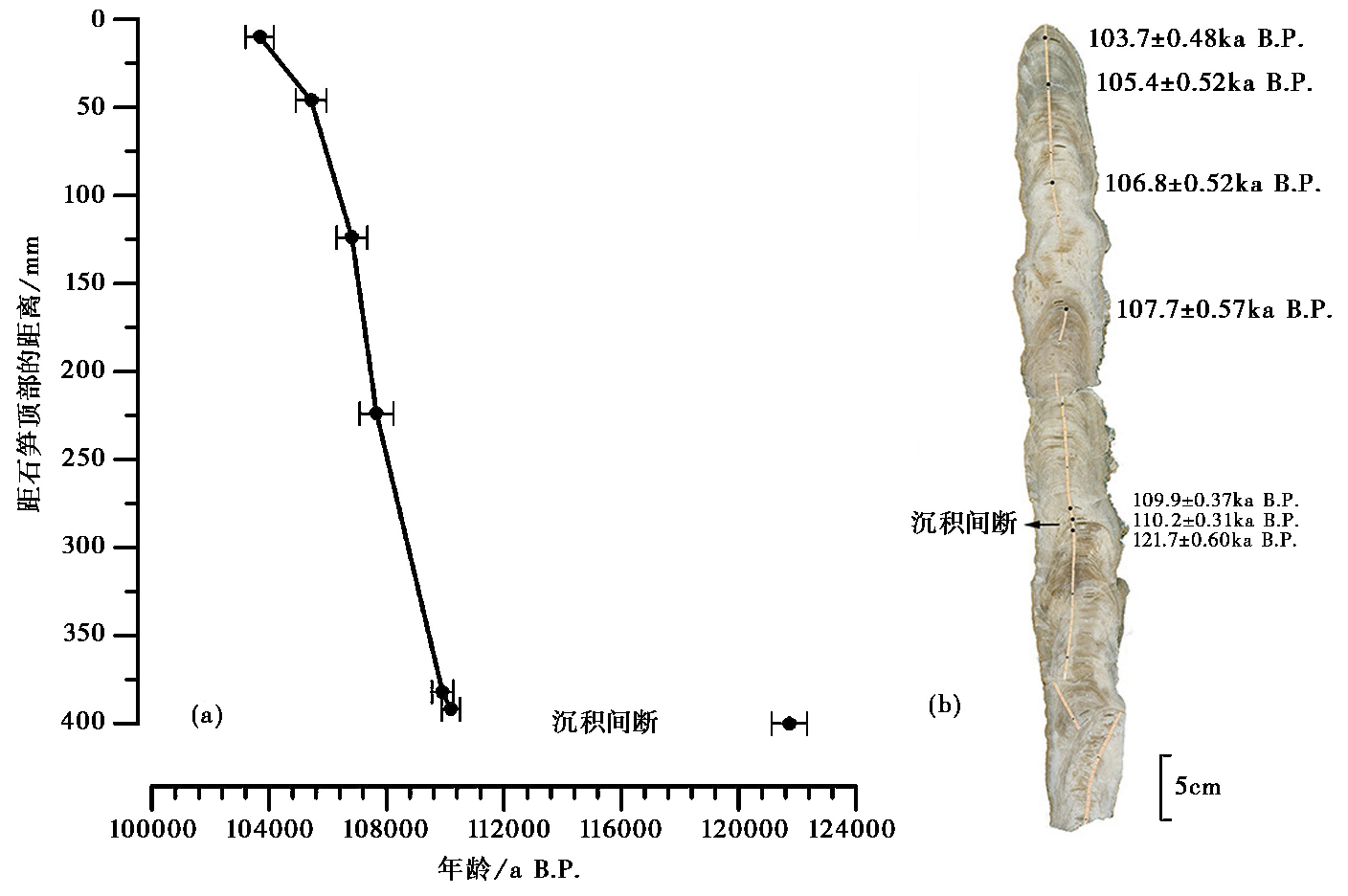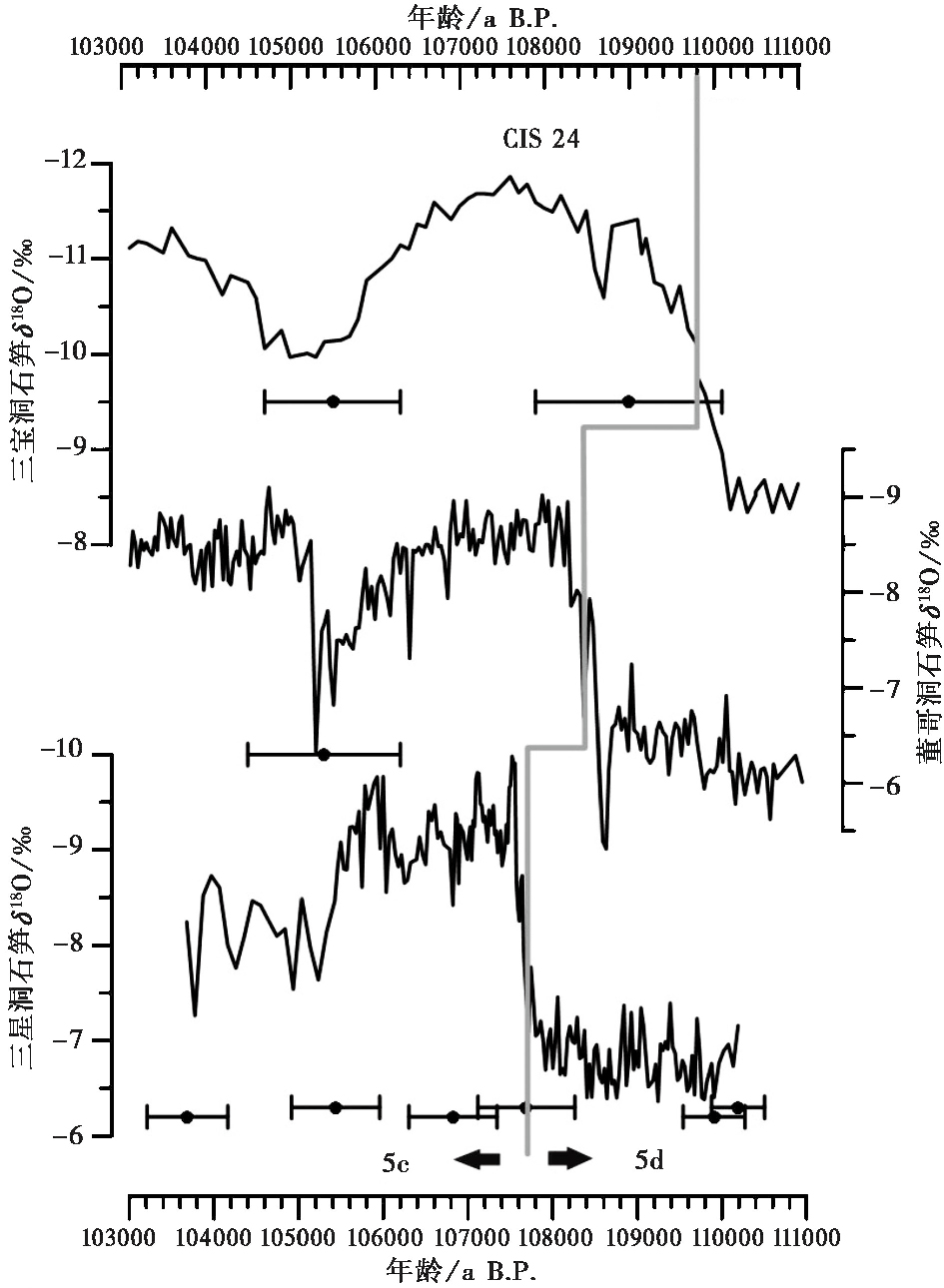格陵兰North GRIP冰芯记录表明,深海氧同位素(MIS)5阶段记录的千年尺度突变事件(Greenland Interstadials(简称GIS)25~21)与MIS3阶段记录的气候突变事件(GIS 17~3)明显不同,其持续时间明显较长且存在亚旋回特征[1]。而在GIS 25~21突变事件中,GIS 24的突变特征最为典型[2],主要表现在3个方面:1)GIS 24事件的氧同位素记录振幅最大(约5‰); 2)温度变幅达16℃,比MIS3阶段的典型GIS事件温度最大变幅15℃[3]更为典型; 3)GIS 24事件的甲烷浓度也在约560a的时间内突变达 214±12ppbv,远高于MIS3阶段的甲烷浓度变幅(80~200ppbv)[4]。GIS 24的突变特征更类似于冰期/间冰期的转换特征,有利于全球各地记录的对比。然而,已有的记录由于定年方法和分辨率不同,GIS 24事件的持续时间差异明显: 格陵兰North GRIP中GIS 24事件持续时间为2.7ka[5],欧洲NAPLS石笋记录的该事件持续时间为3.1ka[6],而湖北三宝洞记录的与之相对应的Chinese Interstadials(CIS)24[7]的持续时间为4.1ka[8]。由于上述差异,各记录之间难以进行细节对比,限制了对该气候突变事件的认识。
最近,高分辨率的石笋记录已经揭示出在MIS3~2阶段东亚季风存在一系列亚千年尺度突变事件,并且和格陵兰冰芯 δ18O揭示的次级冷暖事件具有一一对应关系[9, 10, 11, 12, 13, 14, 15, 16]。尽管亚洲季风区石笋记录在MIS5阶段也取得了一定的进展[17, 18],但是由于年龄模式或者样品分辨率等的问题,目前对于MIS5阶段的千年尺度气候事件认识仅仅体现在是否与格陵兰冰芯GIS事件相对应。最近,高分辨率的格陵兰冰芯记录表明MIS5阶段GIS事件也存在亚千年尺度的特征,主要表现为GIS 24事件的“双峰”特征、 GIS 23事件的“前兆型”特征和GIS 22事件的反弹型特征[1]。对于在MIS5阶段冰量较小条件下,亚洲季风CIS事件是否也存在类似的亚旋回特征?其与北高纬气候的联系及机制仍然需要进一步的研究。
本文选择位于我国西南部贵州省遵义市的三星洞石笋(图 1),通过U/Th定年和氧同位素测试,获得了110.2~103.3ka分辨率为35a的 δ18O时间序列。该石笋 δ18O时间序列记录了完整的CIS 24事件,并识别出4个亚千年尺度的气候振荡。在石笋和高纬度冰芯对比基础上,进一步探讨CIS 24突变事件的起止时间,转型特征及其亚旋回特征。

|
图 1 三星洞地理位置示意图 Fig. 1 Location of the Sanxing Cave |
三星洞(27°22′N,107°11′E)位于贵州省遵义市东南80km处,海拔720m,属中亚热带季风气候区(图 1),兼有亚热带山地季风气候的特点。7月和1月平均气温分别为22.5℃和1.6℃,年平均气温为13.5℃,降雨量为1160~1350mm,主要集中于4~10月。洞穴长约2000m,洞内实测温度为12.8℃(2010年4月),相对湿度达95%~100%。上覆土壤以黄壤和石灰土为主。植被发育良好,以亚热带常绿、 落叶阔叶混交林为主[19]。该洞穴石笋样品U含量高,生长速率快,是研究季风气候突变事件的理想地点[14]。
1.2 样品和测试方法石笋SX15a样品长约650mm,直径约65mm; 采集于距洞口800m的洞厅。石笋外表风化严重,灯照下略显透明。沿生长轴切开并抛光,剖光面呈白色和淡黄色相间分布。另外,在据顶393mm处存在一暗色条带(图 2b),石笋的生长轴发生偏移,有可能为沉积间断。石笋剖面由纯净方解石晶体组成,部分层段存在溶孔。在石笋抛光面上,用直径为0.9mm牙钻总计获取了7个铀系年代样,在台湾大学高精度质谱与环境变迁实验室(HISPEC)完成。化学实验方法参照Shen等[20],分析仪器为MC-ICP-MS Neptune,方法参考Shen等[21],测年结果见表 1。

|
图 2 三星洞SX15a 230Th年代模型(a)及石笋剖面(b) 误差棒表示230Th测年点及测年误差(±2σ) Fig. 2 SX15a 230Th dating model(a) and profile(b) from Sanxing Cave. Error bars represent the dating points and dating errors |
| 表 1 SX15a石笋MC-ICP-MS铀系测年结果* Table 1 MC-ICP-MS U-series dating results for stalagmite SX15a |
同时,沿石笋生长中心轴采用0.5mm钻头,2mm钻取1个氧同位素样品,采用连续流Gasbench Ⅱ装置与Finnigan MAT-253型质谱仪联机测试,每9个样品加测一个标准样品(NBS-19),共测试样品194个,结果以 δ18O(PDB标准)表示,计算公式为 δ18O=[(18O/16O样品/18O/16O标准)-1]×1000,分析误差(±2σ)优于0.1‰,由福建师范大学同位素实验室测试。
2 结果与讨论 2.1 铀钍测量及时间标尺表 1给出石笋SX15a的铀钍同位素及浓度测量、 实测年代及其误差(±2σ)范围。定年结果显示SX15a样品 238U含量较高(1~3ppm),232Th的含量低(400~600ppt),230Th/232Th比值较大,测年误差相对偏小,精度优于4‰。从表 1实测年代数据可以看出,顶部393mm处的确为沉积间断,这与石笋剖面所反映的沉积岩性相符(见图 2b),在此时段石笋生长停止了约11ka,本文主要研究此沉积间断以上(据顶1~390mm)层段。根据 230Th实测年代计算出各段的沉积速率,以内插法和外推法建立SX15a的时间标尺(图 2a),从而获得了110.2~103.3ka B.P.时段平均分辨率为35a的氧同位素序列。三星洞石笋铀钍定年的精确度较高,年龄最大误差为±0.6ka,最小仅有±0.31ka。
2.2 氧同位素记录及其意义图 3给出了三星洞石笋氧同位素记录,以及与已发表的贵州董哥洞[18]和神农架三宝洞[8]高分辨率的 δ18O记录进行对比,在轨道尺度上3个记录整体趋势相当,在MIS5d时期,3个石笋 δ18O值整体偏正,在MIS5c时期,3个石笋 δ18O值整体偏负,3个记录的 δ18O振幅均为2.5‰。3个洞穴的 δ18O记录在长期趋势和振荡幅度上具有良好的一致性,说明三星洞石笋 δ18O反映了大尺度亚洲季风环流特征。已有的研究结果表明,亚洲季风区石笋氧同位素在轨道、 千年和百年尺度上主要反映了夏季风降水 δ18O值变化的信息[8, 22, 23, 24, 25, 26, 27]。δ18O值正偏表示夏季风较弱,与之相反,δ18O的值负偏,表示夏季风强劲。当然,三者记录的CIS 24持续时间存在明显的差异,三宝洞[8]、 董哥洞[18]和三星洞记录的CIS 24的持续时间分别为4.1ka、 2.9ka和2.3±0.5ka,三星洞石笋记录在CIS事件附近有6个高精度U/Th年龄,而且在CIS 24事件的开始和结束时均有U/Th年龄控制,因而三星洞石笋记录更为准确的获得了CIS 24事件的持续时间(图 3)。

|
图 3 三星洞与董哥洞、三宝洞石笋 δ18O记录对比图 5c和5d为MIS5的亚阶段,黑点及误差棒为测年点及测年误差 Fig. 3 Comparison of δ18O records of Sanxing,Dongge and Sanbao caves. 5c and 5d are substages of MIS5,black spotsand the error bars represent the dating points and dating errors |
从图 3对比可见,三星洞石笋记录在以下几个方面优于早期的中国季风区的石笋记录:1)三星洞 δ18O记录的平均分辨率约为35a,高于分辨率约为120a的三宝洞记录,与分辨率约30a的董哥洞 δ18O记录大致相当; 2)三宝洞和董哥洞在此时段的时间标尺分别仅有2个和1个U/Th定年点控制,且测年误差较大(0.8~1.1ka),而三星洞则有6个U/Th定年点控制,年龄精度均优于0.6ka; 3)高分辨率的三星洞 δ18O记录更有利于研究CIS 24事件转型特征和亚旋回特征。
3 讨论 3.1 CIS 24突变事件的年代标定高分辨率的三星洞石笋 δ18O记录清晰的捕捉到了CIS 24气候突变事件,且在CIS 24事件的开始和结束时均有U系年龄控制(图 4),年龄误差均<0.6ka。根据突变过程中间点的位置确定其开始时间为 107.7±0.6ka,结束时间为 105.4±0.5ka,持续时间约2.3±0.5ka,为CIS 24事件迄今最为准确的起止年代。CIS 24事件开始时,石笋 δ18O在100a内从-8.25‰迅速负偏至-10.0‰,振幅达到1.8‰,呈现出CIS 24事件发生的迅速性,表明夏季风开始快速增强; CIS 24事件结束时,石笋 δ18O值在600a左右从-9.7‰偏正为-8.5‰,振幅为1.2‰。

|
图 4 三星洞石笋 δ18O记录与格陵兰 NGRIP冰芯 δ18O记录[5]对比 1、 2、 3和4分别代表CIS 24和GIS 24的亚千年尺度事件; 黑点和 误差棒代表石笋定年点及误差,误差棒(灰色)代表冰芯时标的误差 Fig. 4 Comparison of δ18O records of Sanxing and North GRIP. 1,2,3 and 4 represent four sub-millennial scale events; Black spots and the error bars represent the dating points and dating errors in stalagmite; Error bars(gray)represent error of the ice core time scales |
与CIS 24事件发生的突变相比,CIS 24事件结束则呈现相对缓慢的正偏特征,夏季风相对缓慢的减弱。先前研究表明,中国季风区石笋 δ18O记录CIS事件与格陵兰冰芯记录的GIS事件一一对应[8, 22],且高精度的U/Th定年的石笋记录可以用来校正格陵兰冰芯的时标[25, 28]。但在MIS5时期中国石笋 δ18O记录仅有在上一次冰期/间冰期弱季风结束时(129ka B.P. )的终止点Ⅱ定年精度很高(约±0.1ka)[25],因而终止点Ⅱ已经用做调谐冰芯记录时间标尺的控制点。但在MIS5其他时段,由于目前中国的石笋记录定年误差较大(0.7~2.4ka)且分辨率相对不高,没有控制点用来调谐冰芯时标[29]。三星石笋记录对CIS 24的精确标定可以成为关键的控制点进一步校正冰芯时标。根据石笋记录的CIS事件与格陵兰冰芯记录的GIS事件对应关系[8, 22],三星洞石笋 δ18O在CIS 24事件开始的突变过程可与格陵兰North GRIP冰芯GIS 24事件开始的突变过程相对应,可以将格陵兰North GRIP冰芯时标[5]系统偏老约0.9ka(图 4),这一误差在两个记录的年龄误差范围内。
三星洞石笋 δ18O记录的CIS 24事件呈现出快速增湿、 相对缓慢变干的过程,对应于North GRIP冰芯记录的GIS 24事件[5]快速增温、 快速降温的过程。这种转型特征的差异,可能是由于年龄模式引起的,还需要进一步的研究。在冰芯时标和三星洞U/Th年龄的年龄误差范围之内,三星洞石笋记录的CIS 24事件与North GRIP冰芯记录的GIS 24事件[5]在持续时间上相近,分别为2.3±0.5ka与2.7ka,两者良好的对应关系说明三星洞石笋 δ18O记录所反映的季风强度与极地温度变化在千年尺度上的遥相关。
3.2 CIS 24事件的亚旋回特征尽管三宝洞和董哥洞石笋都记录了CIS 24事件,但是事件的亚旋回特征并不明显(图 3)。高分辨率的三星洞石笋氧同位素记录识别出CIS 24事件内部存在4次亚千年尺度的气候振荡事件(图 4)。分辨率为35a的三星洞石笋 δ18O记录显示亚洲季风在CIS 24内部表现为4个季风增强阶段: 第一阶段距顶194~218mm,δ18O振幅为1.7‰,持续时间约为200a; 第二阶段距顶124~194mm,δ18O振幅为0.6‰,持续时间约为580a; 第三阶段距顶92~124mm,δ18O振幅为1.5‰,持续时间约为570a; 第四阶段距顶46~92mm,δ18O振幅为1.2‰,持续时间约为830a。三星洞石笋所记录的4个亚千年尺度的季风增强事件,与North GRIP冰芯记录的GIS 24事件[5]的4个亚千年尺度暖事件一一对应(图 4)。GIS 24事件整体处于MIS5c时期,MIS 5c为亚冰阶,在这一时期,全球冰量相对较小[30],湿度上升[31],降雨增加气候相对暖湿,淡水频繁注入北大西洋,导致北大西洋经向环流(AMOC)不稳定[32],正是这时期的AMOC不稳定有可能造成了GIS 24事件的亚千年气度的气候变化[1]。三星洞石笋 δ18O记录的季风气候与北高纬气候之间的耦合关系,表明了在冰量相对较小的边界条件下,东亚夏季风强弱仍与北高纬气候变化密切相关。
4 结论(1)高分辨率的三星洞石笋 δ18O序列清晰的捕捉到了CIS 24气候突变事件的结构特征:CIS 24事件开始时(107.7±0.6ka),石笋记录指示在100a内 δ18O从-8.25‰迅速负偏至-10.0‰,表明夏季风开始快速增强; CIS 24事件结束时(105.4±0.5ka),石笋 δ18O在约600a内从-9.7‰偏正为-8.5‰,与CIS 24事件发生的突变相比,CIS 24事件结束则呈现相对缓慢的正偏特征,夏季风相对缓慢的减弱; CIS 24事件整体持续时间约为 2.3±0.5ka。
(2)高分辨率的三星洞石笋 δ18O序列揭示出CIS 24事件内存在4个亚千年尺度的夏季风增强事件,与格陵兰North GRIP冰芯记录的GIS 24事件的4个亚千年尺度暖事件相对应,表明在冰量相对较小的边界条件下,东亚夏季风强弱仍与北高纬气候变化密切相关。
致谢 感谢审稿专家和杨美芳编辑对本文的细心审阅和提出的宝贵修改意见,感谢台湾大学沈川洲教授为本文测试的部分铀钍年龄和张辉在野外工作中提供的帮助。
| 1 | Capron E, Landais A, Chappellaz J et al. Millennial and sub-millennial scale climatic variations recorded in polar ice cores over the last glacial period. Climate of the Past, 2010,6(1):135~183 |
| 2 | Sachs J P, Repeta D J. Oligotrophy and nitrogen fixation during Eastern Mediterranean sapropel events. Science, 1999,286(5449):2485~2488 |
| 3 | Huber C, Leuenberger M, Spahni R et al. Isotope calibrated Greenland temperature record over Marine Isotope Stage 3 and its relation to CH4. Earth and Planetary Science Letters, 2006,243(3~4):504~519 |
| 4 | Chappellaz J. Synchronous changes in atmospheric CH4 and Greenland climate between 40 kyr and 8 kyr BP. Nature, 1993,366(6454):443~445 |
| 5 | North Greenland Ice Core Project Members. High-resolution record of Northern Hemisphere climate extending into the last interglacial period. Nature, 2004,431(7005):147~151 |
| 6 | Boch R, Cheng H, Spötl C et al. NALPS:A precisely dated European climate record 120~60ka. Climate of the Past, 2011,7(4):1247~1259 |
| 7 | Cheng H, Edwards R L, Wang Y J et al. A penultimate glacial monsoon record from Hulu Cave and two-phase glacial terminations. Geology, 2006,34(3):217~220 |
| 8 | Wang Y J, Cheng H, Edwards R L et al. Millennial- and orbital-scale changes in the East Asian monsoon over the past 224,000 years. Nature, 2008,451(7182):1090~1093 |
| 9 | 赵侃, 孔兴功, 程海等. MIS3晚期东亚季风强度和DO事件年龄. 第四纪研究, 2013,28(1):177~183 Zhao Kan, Kong Xinggong, Cheng Hai et al. Intensity and timing of DO events of East Asian monsoon during the late episode of MIS3. Quaternary Sciences, 28(1):177~183 |
| 10 | 刘殿兵, 汪永进, 陈仕涛等. 东亚季风MIS3早期DO事件的亚旋回及全球意义. 第四纪研究, 2008,28(1):169~176 Liu Dianbing, Wang Yongjin, Chen Shitao et al. Sub-Dansgaard-Oeschger events of East Asian monsoon and their global significance. Quaternary Sciences, 2008,28(1):169~176 |
| 11 | 崔英方, 汪永进, 刘殿兵. 黔西南雾露洞石笋记录的MIS3晚期亚洲季风变化和南北极气候的联系. 海洋地质与第四纪地质, 2011,31(3):101~107 Cui Yingfang, Wang Yongjin, Liu Dianbing. High-resolution stalagmite δ18O records of Asian monsoon changes in southwest Guizhou during the late episode of MIS3:A test of the bi-polar see-saw model at centennial scale. Marine Geology & Quaternary Geology, 2011,31(3):101~107 |
| 12 | Liu D B, Wang Y J, Cheng H et al. Sub-millennial variability of Asian monsoon intensity during the early MIS3 and its analogue to the ice age terminations. Quaternary Science Reviews, 2010,29(9):1107~1115 |
| 13 | 陈仕涛, 汪永进, 吴江莹等. 东亚季风气候对Heinrich 2 事件的响应:来自石笋的高分辨率记录. 地球化学, 2006,35(6):586~592 Chen Shitao, Wang Yongjin, Wu Jiangying et al. An event of the East Asian monsoon responding to Heinrich Event 2:Evidence from high-resolution stalagmite record. Geochimica, 2006,35(6):586~592 |
| 14 | 何尧启, 姜修洋. 黔北洞穴石笋记录的GIS-8事件亚旋回特征. 第四纪研究, 2012,32(3):561~562 He Yaoqi, Jiang Xiuyang. Sub-Greenland-Interstadial 8 event of Asian monsoon from a stalagmite record in northern Guizhou Province. Quaternary Sciences, 2012,32(3):561~562 |
| 15 | 彭子成, 张兆峰, 蔡演军等. 贵州七星洞晚更新世晚期石笋的古气候环境记录. 第四纪研究, 2002,22(3):273~282 Peng Zicheng, Zhang Zhaofeng, Cai Yanjun et al. The paleoclimatic records from the Late Pleistocene stalagmite in Guizhou Qixing Cave. Quaternary Sciences, 2002,22(3):273~282 |
| 16 | 陈琼, 刘淑华, 米小建等. 川东北石笋记录的 GIS 4~5 夏季风气候变化及与高纬气候的联系. 第四纪研究, 2014,34(6):1264~1269 Chen Qiong, Liu Shuhua, Mi Xiaojian et al. Speleothem-derived Asian summer monsoon variations during Greenland Interstadials 4 to 5 in NE Sichuan, Central China and teleconnections with high latitude climates. Quaternary Sciences, 2014,34(6):1264~1269 |
| 17 | 周厚云, 迟宝泉, 关华政等. 东亚夏季风石笋记录中缺失格陵兰间冰段25?第四纪研究, 2008,28(1):186~187 Zhou Houyun, Chi Baoquan, Guan Huazheng et al. No Greenland Interstadial 25 in speleothem-derived East Asian monsoon record?Quaternary Sciences, 2008,28(1):186~187 |
| 18 | Kelly M J, Edwards R L, Cheng H et al. High resolution characterization of the Asian monsoon between 146,000 and 99,000 years B.P. from Dongge Cave, China and global correlation of events surrounding Termination Ⅱ. Palaeogeography, Palaeoclimatology, Palaeoecology, 2006,236(1):20~38 |
| 19 | 姜修洋, 王晓艳, 杨邦等. 黔北石笋记录的MIS5d/5c季风突变过程. 科学通报, 2014,59(27):2698~2706 Jiang Xiuyang, Wang Xiaoyan, Yang Bang et al. Stalagmite-inferred abrupt climate change in the East Asian monsoon at MIS5d/5c in northern Guizhou Province. Chinese Science Bulletin, 2014,59(27):2698~2706 |
| 20 | Shen C-C, Cheng H, Edwards R L et al. Measurement of attogram quantities of 231Pa in dissolved and particulate fractions of seawater by isotope dilution thermal ionization mass spectroscopy. Analytical Chemistry, 2003,75(5):1075~1079 |
| 21 | Shen C-C, Wu C-C, Cheng H et al. High-precision and high-resolution carbonate 230Th dating by MC-ICP-MS with SEM protocols. Geochimica et Cosmochimica Acta, 2012,99:71~86 |
| 22 | Wang Y J, Cheng H, Edwards R L et al. A high-resolution absolute-dated Late Pleistocene monsoon record from Hulu Cave, China. Science, 2001,294(5550):2345~2348 |
| 23 | Yuan D X, Cheng H, Edwards R L et al. Timing, duration, and transitions of the last interglacial Asian monsoon. Science, 2004,304(5670):575~578 |
| 24 | Zhang P Z, Cheng H, Edwards R L et al. A test of climate, sun, and culture relationships from an 1810-year Chinese cave record. Science, 2008,322(5903):940~942 |
| 25 | Cheng H, Edwards R L, Broecker W S et al. Ice age terminations. Science, 2009,326(5950):248~252 |
| 26 | 程海, 艾思本, 王先锋等. 中国南方石笋氧同位素记录的重要意义. 第四纪研究, 2005,25(2):157~163 Cheng Hai, Edwards R L, Wang Xianfeng et al. Oxygen isotope records of stalagmites from Southern China. Quaternary Sciences, 2005,25(2):157~163 |
| 27 | 吴江滢, 汪永进, 董进国. 全新世东亚夏季风演化的辽宁暖和洞石笋 δ18O记录. 第四纪研究, 2011,31(6):990~998 Wu Jiangying, Wang Yongjin, Dong Jinguo. Changes in East Asian summer monsoon during the Holocene recorded by stalagmite δ18O records from Liaoning Province. Quaternary Sciences, 2011,31(6):990~998 |
| 28 | Shackleton N J, Fairbanks R G, Chiu T C et al. Absolute calibration of the Greenland time scale:Implications for Antarctic time scales and for absolute calibration of the Greenland time scale:Implications for Antarctic time scales and for Δ14C. Quaternary Science Reviews, 2004,23(14):1513~1522 |
| 29 | Parrenin F, Barnola J M, Beer J et al. The EDC 3 chronology for the EPICA Dome C ice core. Climate of the Past, 2007,3(3):485~497 |
| 30 | Lisiecki L E, Raymo M E. A Pliocene-Pleistocene stack of 57 globally distributed benthic δ18O records. Paleoceanography, 2005,20(1):PA1003, doi:10.1029/2004PA001071 |
| 31 | 姚檀栋, Thompson L G, 施雅风等. 古里雅冰芯中末次间冰期以来气候变化记录研究. 中国科学(D 辑), 1997,27(5):447~452 Yao Tandong, Thompson L G, Shi Yafeng et al. The study of the climate change records in the Guliya ice core since the Last Inter-glacial. Science in China (Series D), 1997,27(5):447~452 |
| 32 | Khodri M, Leclainche Y, Ramstein G et al. Simulating the amplification of orbital forcing by ocean feedbacks in the last glaciation. Nature, 2001,410(6828):570~574 |
Abstract
Recently published North GRIP ice core records precisely described the abrupt changes of the Greenland temperature during Marine Isotopic Stage(MIS) 5 with three stages of sub-millennial scale events. However, it remains uncertain about the behaviors of the Chinese Interstadials(CIS) events sub-cycle variability and its the linkages with the northern high latitudes during this period. Sanxing Cave(27°22'N, 107°11'E; 720m a.s.l.) with a depth of ca.2km, is located in Tiechang Town, ca.70km southeast of Zunyi City, Guizhou Province, Southwest China. This region is strongly influenced by the Asian summer monsoon(ASM) with the peak monsoon precipitation in the summer(JJA) and the dry season in winter(DJF). The annual average precipitation is ca.1000mm and the mean temperature is 13.5℃. Cave temperature is 12.8℃(in April 2010). This region is dominated by the subtropical broadleaf evergreen and deciduous mixed forests. From 7 high-precision 230Th ages and 194 oxygen isotope data points, a stalagmite from Sanxing Cave(SX15a) in northern Guizhou Province reveals the precipitation history of the ASM from 110.2ka B.P. to 103.3ka B.P. (relative to 1950A.D.). The stalagmite sample length is ca.650mm, diameter is ca.65mm. Each sub-sample for δ18O measurements was milled using dental burrs in size of 0.5mm along the length of the stalagmite profiles parallel to the central growth axis. Spacing between samples was 2mm. A total of 194 powdered sub-samples for δ18O measurements were performed by a Finnigan MAT-253 mass spectrometer connected to an on-line automated preparation system(Gasbench Ⅱ). Results were reported relative to the Pee Dee Belemnite(PDB) standard and standardization was accomplished using NBS-19. Seven sub-samples were dated with the U-series methods. U-Th isotopic compositions and concentrations were determined on a Thermo-Fisher NEPTUNE multi-collection inductively coupled plasma mass spectrometer(MC-ICP-MS). All date errors given are two standard deviations(2σ). The high-resolution δ18O record reveals the detailed process of Chinese Interstadials(CIS) event 24. Our records indicate an abruptly negative shift from -8.25‰ to -10.0‰ at 107.7±0.6ka and a positive shift from -9.7‰ to -8.5‰ at 105.4±0.5ka. The duration of this event is about 2.3±0.5ka. In the period of CIS 24, our high resolution δ18O record reveals four sub-millennial scale events with enhanced ASM, which are in close correlation with sub-cycles recorded in the equivalents of Greenland ice cores. We show for the first time that the sub-millennial scale climatic events of CIS 24 occurred more or less synchronously between ASM and North high latitude, indicating that the North high latitude climate exert an important influence in the ASM at the conditions with a relatively small ice volume.
 2015, Vol.35
2015, Vol.35

